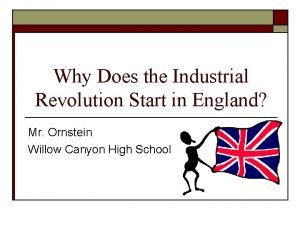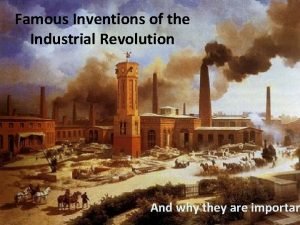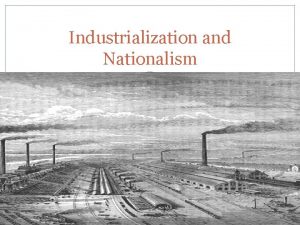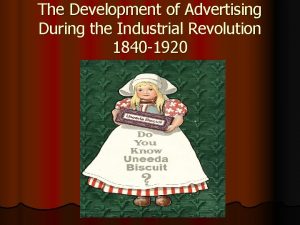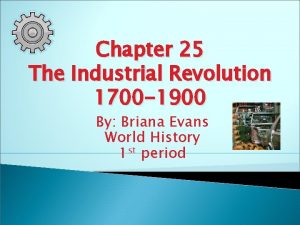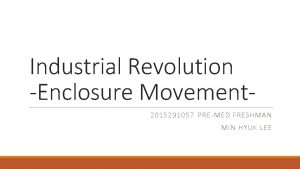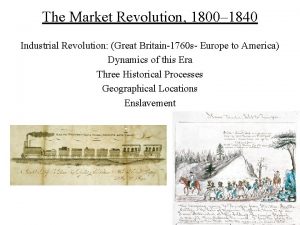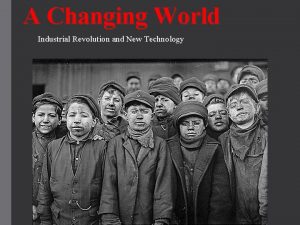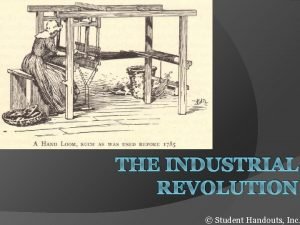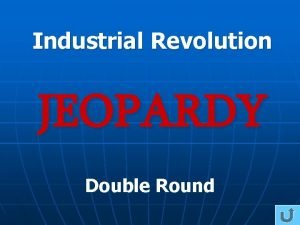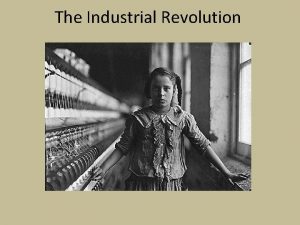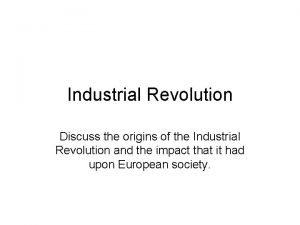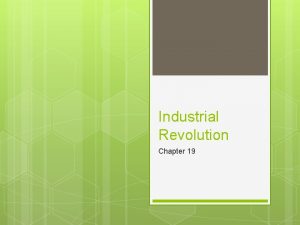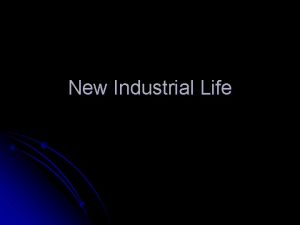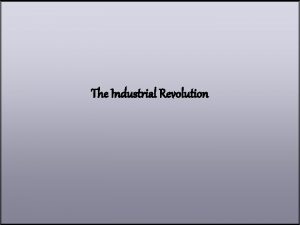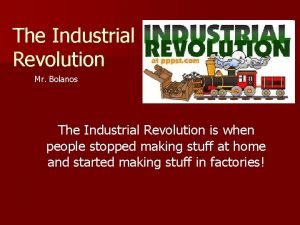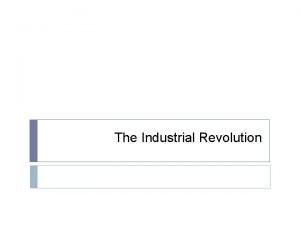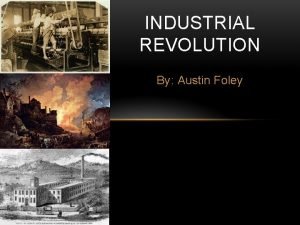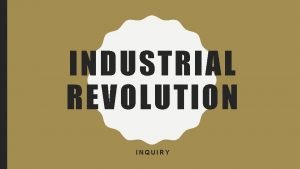The Industrial Revolution Origins of the Industrial Revolution
















- Slides: 16

The Industrial Revolution

Origins of the Industrial Revolution • Agricultural Revolution • Factors of Production • New Technology & the Textile Industry • Steam Engines, Iron & Steel

Agricultural Revolution • Big Idea: Changes in farming methods, caused many farm workers to be replaced by machines. • The enclosure movement divided land into individual plots • Jethro Tull invented the seed drill to plant crops in straight lines, using land seed more effectively. • Crop rotation helped farmers produce more crops on the same amount of land. • Iron plows replaced wooden ones and made farming more efficient. • Many farm workers began to move to cities in search of work, since they were no longer needed to farm the land.

Why Great Britain Industrialized First • The needed Factors of Production: Land, Labor & Capital existed in Britain. • Land: Natural Resources (coal, iron ore, rivers & harbors for waterpower and shipping) • Labor: Huge migration of people from the countryside to cities provided the population to run factories • Capital: Tools, Machinery, Equipment, Money

The Textile Industry • Big Idea: New technology to produce cloth led to mechanization. • Mechanized Loom (1730) • The Spinning “Jenny” (1760 s)– A machine that could produce 8 x more thread than a traditional spinning wheel. • Spinning Mill (1780)– The beginning of the factory system in which waterpower was used to run the Spinning Jenny and workers began to put in a certain number of hours a day for fixed pay. • Cotton Gin (1793)—Invented by Eli Whitney; a machine that cleaned seeds from cotton. This produced more cotton to make into cloth.

Steam Engines, Iron & Steel • Waterpower had its drawbacks; factories had to be located close to a river or water source. • Steam Engine (1769)– was converted to power spinning and weaving machines. • Iron and Coal—the 2 major raw materials of modern industry, but steam engines powered by iron and coal often exploded. • Steel— Bessemer Process (1850 s) led to producing cheaper steel, which would be used to build factories and machines.

Division of Labor • Division of Labor: The Industrial Revolution changed the way people worked; work was divided into steps; factory owners hired unskilled workers and assigned them to different steps in production. • Division of Labor increased production; machines lowered the cost of production.

Mass Production & Interchangeable Parts • Mass Production: A system of producing large numbers of identical items came into being. Interchangeable parts and the assembly line are needed for mass production. • Interchangeable parts: Parts that can replace each other. Parts were mass produced that could fit the same type of item; this resulted in speedy production and ease of fixing items that were broken. • Henry Ford: Applied mass production through use of the assembly line to automobile production making the car

The Factory System & Effects: Work • Employers wanted workers who could perform a few simple tasks. Workers performed only a small part of creating a finished product. • Skilled workers were no longer needed. • Pay was based on hours worked and goods produced. • Wages were influenced by how much it cost to produce goods; wages were often lowered if land, or capital increased, or if there was an oversupply of workers.

The Factory System & Effects: Work • Workers were constantly worried about losing their jobs. • Rules: Arrive on Time, Few or no breaks, Leave only with permission. • Time: 14 hours a day, 6 days a week; no vacations or sick leave. • Poor conditions: factories were cold in the winter & HOT in the summer; No safety devices on machines; no compensation for injuries on the job. • Children as young as five worked from 5 am- 9 pm.

The Factory System & Effects: Living • Cities became overcrowded as people migrated to find jobs. (example: 1717 Manchester, England’s population= 10, 000; 1851 population=303, 000. ) • Before the industrial revolution most people lived in small villages, or in the countryside; by 1900 most people lived in the cities. • Workers lived in cheap, dirty housing called Tenements because that’s all they could afford. • Up to a dozen people might be crammed into a single room. • (1840) up 50, 000 people living in cellars in Manchester, England.

The Factory System & Effects: Unions • Workers formed unions to try to secure better working conditions. • They protested against poor working conditions and low wages by refusing to work (strikes. ) • Unions collected money (dues) from workers and paid them if they had to strike. • Sometimes employers gave in to the demands of the workers, other times workers lost their jobs.

The Factory System & Effects: Development of the Middle Class • The Industrial Revolution caused the development of the middle class(bankers, manufacturers, merchants, doctors, engineers, professors and their families; other managers that kept the industries running. ) • The middle class was based on economic standing, NOT based on birth. Workers in the working class hoped to climb up into the middle class. • The middle class enjoyed a higher standing of living as compared to previous generations. • Some in the middle class tried to work for reforms to make life better for the working class.

Capitalism • In the late 1800 s Western Europe and the United States were characterized by CAPITALISM: An economic system in which individuals or companies NOT governments, control the factors of production. The means of production are privately owned. • Many capitalists believed in LAISSEZFAIRE “Let it be. ” The belief that government should not interfere with the operations of business. • FREE ENTERPRISE, an enlightenment idea created by Adam Smith, that justified competition unrestricted by laws and government was also supported by capitalists.

Socialism • Many people remained poor as a result of the Industrial Revolution, including the workers, whose labor drove the economy. • Some believed laissez-faire capitalism was not the best economic system. They felt the best way to distribute wealth more evenly was to have SOCIALISM, an economic system in which the government controls the means of production for the benefit of all people. • Socialists wanted to do away with private ownership of companies and free enterprise competition.

Socialism • Karl Marx believed the entire capitalist system should be destroyed and wrote the Communist Manifesto (1848. ) • Marx said that class struggles between those who owned property “the haves” and those who did not “the have nots” characterized each stage of history. • He believed the Proletariat, or working class, in the late 1800 s would rise up against the middle class industry owners, or bourgeoisie in a socialist revolution to gain access to the wealth they were producing. • The proletariat would first control the government by force, but eventually the people would learn the benefit of working together; in a government that controlled economic planning and the means of production, this idea is called communism.
 Could the french revolution have been avoided
Could the french revolution have been avoided Definition of third agricultural revolution
Definition of third agricultural revolution Russian revolution vs french revolution
Russian revolution vs french revolution Why did the industrial revolution start in britain
Why did the industrial revolution start in britain Famous inventions of the industrial revolution
Famous inventions of the industrial revolution Industrialization and nationalism worksheet answers
Industrialization and nationalism worksheet answers The tyger industrial revolution
The tyger industrial revolution Advertising in the industrial revolution
Advertising in the industrial revolution Chapter 25 the industrial revolution
Chapter 25 the industrial revolution Industrial revolution
Industrial revolution Child labour industrial revolution
Child labour industrial revolution Industrial revolution
Industrial revolution Smallpox vaccine inventor industrial revolution
Smallpox vaccine inventor industrial revolution Industrial revolution mean
Industrial revolution mean Effects of industrial revolution
Effects of industrial revolution Long term impacts of the industrial revolution
Long term impacts of the industrial revolution Industrial revolution jeopardy
Industrial revolution jeopardy



